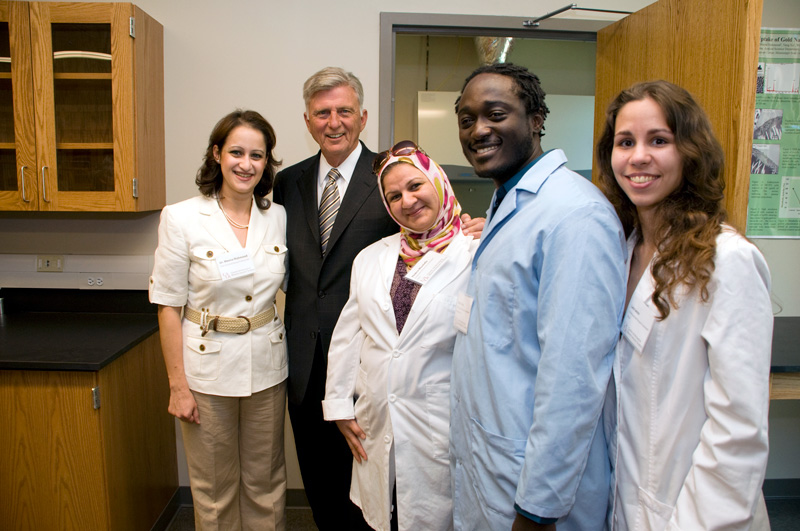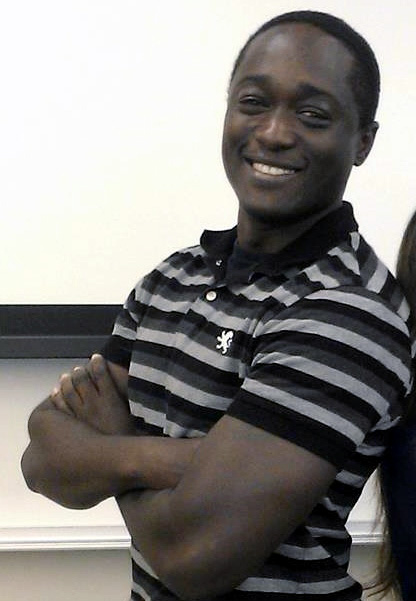Alumni Spotlight: Nanotech center gave student chance at a new life
During the past 11 years, dozens of students have worked at the University of Arkansas at Little Rock Center for Integrative Nanotechnology Sciences.
Undergraduates, graduate students, and even high-schoolers helped shape the center, enriching it with their diverse backgrounds, interests, and personalities. However, few students made an impact on the center like Dereck Oshin, a first-generation American who was looking for a second chance.
In 2006, Center Director Dr. Alex Biris was in Washington, D.C., for a conference, accompanied by UA Little Rock’s then-Vice Chancellor for University Advancement Bill Walker (now retired). While in town, Walker decided to pay an impromptu visit to the Earth Conservation Corps, a nonprofit, AmeriCorps-funded environmental service organization for at-risk youths in the southeast part of the city.
Though just a couple miles from the nation’s Capitol, the center’s neighborhood is anything but presidential. A 2005 “60 Minutes” special described it as “polluted by … drugs, and violent crime,” with 38 percent of its residents living under the poverty line.
Walker had worked with the group in the past, even discussing a scholarship to UA Little Rock for an Earth Conservation Corps student. Biris was unfamiliar with the organization, but he decided to accompany Walker, despite Walker’s warnings about the roughness of the area.
Neither man suspected that the events of the day would change lives.
At the Earth Conservation Corps, Biris spoke with the director, sharing his passion that all should have an opportunity for an education. It’s a belief inspired by his mother, a school principal.
His words and enthusiasm were infectious and inspiring.
“The director stopped Alex mid-conversation and said: ‘Our kids are upstairs, and they need to hear this,’” Walker remembered.
Moments later, Biris found himself giving a talk on nanotechnology and the value of education to a group of underprivileged budding scientists.
Biris had done similar presentations in the past, and he captivated the group. But during the talk, he again found himself doing something unexpected.
Walker said that, entirely unbidden, Biris stopped, pointed directly at a tall African American youth in the audience, and said “Young man, get back in school.”
The room was silent for a moment. Walker tensed, wondering why Biris singled out someone he’d never met. He worried that a fight was about to break out. They were, after all, in one of the most dangerous neighborhoods in America.
Then, to Walker’s surprise, the young man simply replied, “Yes, sir.”
His name was Dereck Oshin. Minutes later, he approached Biris and asked for a scholarship. Oshin’s journey to UA Little Rock began.
Troubled past
Unbeknownst to Biris, Walker’s fear of violence could have very well come true — Oshin was no stranger to getting physical.
“I did fight a lot in school … I had to because I had a smart mouth and had to back it up,” Oshin remembers.
Like most Earth Conservation Corps members, he joined the group to rise above his circumstances. The program, founded by film director Bob Nixon in 1989, sought to give local youths a chance to learn soft and hard skills, while investing in their own neighborhood, and earning a little money.
The organization’s primary task was cleaning up the nearby Anacostia River, in which more than a billion pounds of sewage was being dumped annually. The Corps leaders taught participants practical chemistry, biology, and life science skills, as well as how to communicate and work with others professionally and peacefully.
Thanks to the Corps members’ efforts, a literal toxic wasteland in the Capitol’s backyard was being transformed.
But transforming their own lives was far more complicated — finishing high school, much less starting college, was nearly impossible for many. Drugs, random violence, and a lack of resources often kept them trapped in hopeless situations.
On average, one Corps member every year was murdered. Others died from a lack of adequate healthcare. In fact, the first Earth Conservation Corps member chosen to receive a scholarship to UA Little Rock died of undiagnosed leukemia before he got a chance to start.
Oshin, the son of Nigerian and Beninese parents, had figured out how to survive in the area, always aware of his surroundings and ready to fight. But that wasn’t the life he wanted. He graduated from high school seven years earlier and now was stuck in his circumstances.
“I was getting into trouble with the law consistently, and I wanted to go back to college to get a degree in engineering,” he said.
While the Corps gave him a sense of purpose, it couldn’t get him out of D.C.
During Biris’ visit, Oshin saw his opportunity to escape.

Second chance
The next year, Oshin arrived in Little Rock, and Biris and Walker immediately took the young man under their wings.
As his only connections in the state, they checked in regularly, helping with everything from groceries to homework, making sure he had the resources to succeed. Oshin even stayed with Biris for some time after arriving in Little Rock.
“This is the university of second chances,” Walker said, and he firmly believed it was the right place for Oshin to restart his life.
The transition from a life with no future to a life driven by goals wasn’t easy.
“I came here to get away from the world I created for myself,” Oshin said.
Breaking old habits was one of the most difficult hurdles in his journey. He also missed his family.
But Biris, Walker, and the entire Center for Integrative Nanotechnology Sciences team wouldn’t let Oshin give up.
Glediana Rexha, center outreach and development manager and Biris’ future wife, became one of Oshin’s biggest cheerleaders and challengers, giving him pep talks — and tough love — when needed.
A new life
Surrounded by this support, Oshin slowly but surely pushed toward his goals.
“My motivation to work hard and finish was to not let anyone down who has helped me and, most of all, to do what I told myself I could do and become,” he said.
At the beginning of his second semester, Oshin began working as a research assistant in the center’s labs, a position he earned based on his academic performance. This experience took the science he previously learned to a new level.
“I helped research carbon nanotube synthesis, thin films, and superhydrophobicity. I also gained skills on using and maintaining high-level instrumentation,” he said.
In 2015, Oshin graduated from UA Little Rock with a Bachelor of Science degree in systems engineering. He moved back to the Washington, D.C., area and started a new life, having done precisely what he set out to do eight years earlier.
Today, he is a security engineer at a Maryland-based product certification company.
He and Biris still talk regularly.
